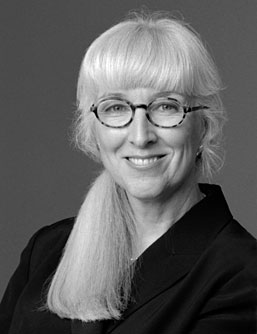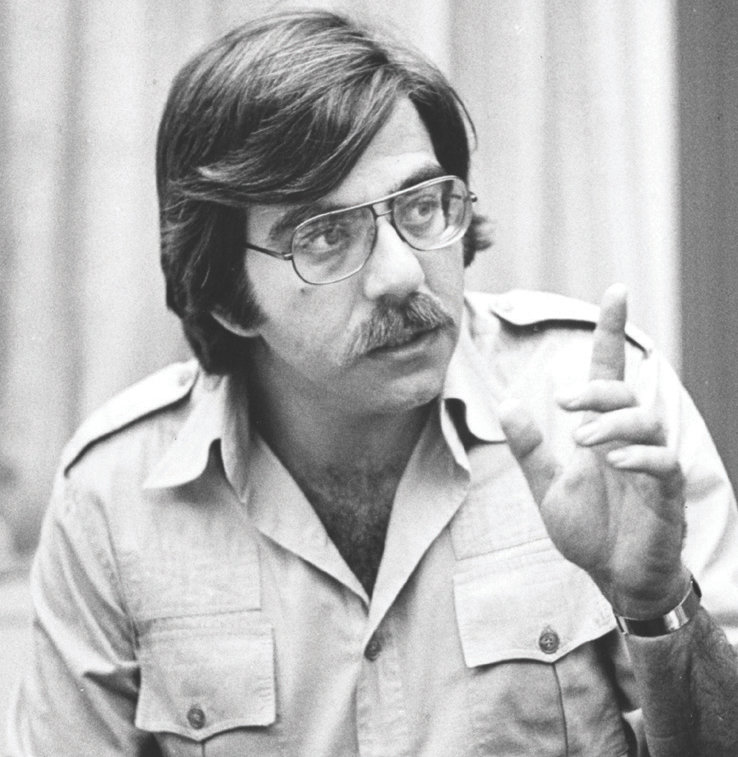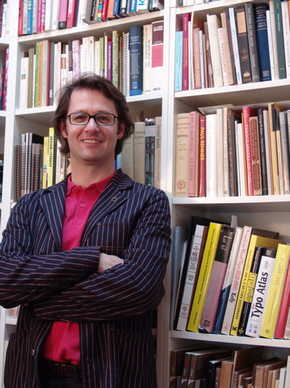<Back to Index>
- Graphic Designer Katherine McCoy, 1945
- Graphic Designer Alan Peckolick, 1940
- Type Designer Jean François Porchez, 1964
PAGE SPONSOR

Katherine McCoy (born Katherine Jane Braden in Decatur, Illinois, October 12, 1945) is an American graphic designer and educator, best known for her work as the co-chair of the graduate Design program for Cranbrook Academy of Art.
During her extensive career spanning education and professional
practice, McCoy worked with groundbreaking design firm Unimark, Chrysler
Corporation, and with Muriel Cooper in the early days of MIT Press
while at the Boston design firm Omnigraphics. McCoy's career in
education was similarly broad, teaching at Cranbrook Academy of Art,
Illinois Institute of Technology’s Institute of Design, and the Royal
College of Art,
London. She is also the co-founder of High Ground Designers, a workshop
firm created for professional designers in their studios.
Shortly after graduation, McCoy joined Unimark International, a design firm led by many key figures in American Modernist graphic design, including Massimo Vignelli, Ralph Eckerstrom of Container Corporation, Jay Doblin and Herbert Bayer. It was at the interdisciplinary Unimark offices where McCoy was exposed to the strict Swiss typographic and design approaches which came to permeate much of American corporate communications through the late 1960s and 70s.
Following Unimark, McCoy worked for a year in the corporate identity offices of the Chrysler Corporation, then joined the Boston design firm Omnigraphics, where she worked on several projects for the MIT Press with Muriel Cooper. Next she joined Designers & Partners, the Detroit advertising design studio where she met the designer - illustrator - cartoonist Edward Fella. Designers and Partners focused solely on working with advertising agencies and had a staff that included a wide variety of graphic arts professionals, including illustrators, cartoonists, and “lettering men” as well as graphic designers. Although McCoy was not particularly fond of working with ad agencies, the opportunities she was given and connections she made allow partially for her success today. She also worked with other professional practices including Xerox Education Group, and major advertising agencies.
In 1971 McCoy began her career in design education when she was appointed co-chair of the Cranbrook Academy of Art graduate design program with her husband Michael McCoy. While McCoy led the graphic design program, and Michael McCoy led the industrial design program, both 2D and 3D design students shared studios, and explored interdisciplinary approaches towards designing. Katherine claims she "combined the “objective” typographic approach that she knew through professional practice with an interest in the social and cultural activism that was in the air in the late '60s" when creating and reinventing the program. Early conceptual influences on the Cranbrook design approach were Robert Venturi's book Learning from Las Vegas, Richard Saul Wurman's publishing on the man - made environment, and McCoy's own interest in social design and design vernacular. The commercial vernacular collages of Edward Fella, the Basel experiments of Wolfgang Weingart and a Yale project by Dan Friedman were visual design influences. Later sources included semiotics, post - structuralism, literary theory and deconstruction; both the students' and McCoy's work experimented with applications of these ideas to communications design. Katherine designed a lot of material for the Cranbrook educational community including quarterly magazines, catalogs, posters and other projects that she and Michael produced as McCoy & McCoy.
Reinvented by the McCoys, the program was organized around experimentation in the studio, with minimal structure or assignments. There were deadlines, papers, or finals. Only a final thesis was required in the end of the program. However, the McCoys did require students to read about the history and theory behind the area of design they were entering. This was done “in order to really understand the context in which each student was going to be entering”. Each student is encouraged to develop their own voice in design, within a mix of different radical and new experiments, sometimes done with the McCoys. Students also had the opportunity to work directly with Katherine McCoy, and this became the counterbalance for the experimental work in the Cranbrook Art School. This process that Katherine and Michael McCoy had brought to the program had began a revolution of change in many aspects. It exemplified the transformation of the design program itself and the studios, along with its critiques, centered around the possibility of breaking away from the normal everyday practice of design.
Although the McCoy’s program was sometimes thought to be controversial, their tenure at Cranbrook resulted in the graduation and success of many known designers, including Lorraine Wild, Edward Fella, Nancy Skolos and Tom Wedell, P. Scott Makela, Andrew Blauvelt, Lucille Tenazas, Meredith Davis and Patrick Whitney. After McCoy left Cranbrook in 1995, she held several other teaching positions. Her best known position with the Illinois Institute of Technology's Institute of Design, from 1995 – 2003, and the Royal College of Art in London.
In the 1970's, Katherine McCoy took two major leaps to advance the program, in terms of student work. First, she began to change the introductory typography projects to allow students a new semiotic interpretation. This allowed students to begin to drive to the solutions and to depart from the strict Modernist vocabulary used in the program in previous years. Included are stylistic elements that had previously been underused by Modernist typographers, such as historical or vernacular type forms or images. The second leap was to allow the more advanced and able students to take lead on the exploration of theory.
In 1991, Katherine and Micheal McCoy, along with a large team of 2-D and 3-D students, produced the book Cranbrook Design: The New Discourse. The book documented the visuals of the work that had been produced in the Cranbrook studios during the 1980s, and it "probably sealed the reputation of the school as being a place where the visual quality of the work, sometimes generated by a highly creative interpretation of theory, took precedent without regard to the “needs” of the profession". The critiques of the work represented in the book was often voiced without knowledge of the actual discourse of the studio critique. Lead by the McCoys, it challenged the experimentation to be as real as possible.
After 24 years of creative work, the McCoys left their positions in 1995. They moved to Chicago where they spent every fall semester at the Illinois Institute of Technology's Institute of Design, giving senior lectures and seminars until 2004. Katherine moved away from studio teaching and instead been concentrating more on theoretical issues. Mostly issues having to do with both the teaching and practice of graphic design in the context of new media.
- McCoy now consults in communications design, design curriculum planning at Kansas City Art Institute and post - professional design education as a partner of McCoy & McCoy, and High Ground Tools and Strategies for Design. High Ground Design is a series of workshops created by Katherine and her husband, Michael McCoy for other professional designers to work in their studio. High Ground is dedicated to expanding design skills and methods, as well as opening up to the vision of design, questioning assumptions and redefining the nature of design.

Alan Peckolick (October 3, 1940 Bronx, NY - August 3, 2017) was an American graphic designer, artist, and photographer.
Peckolick is known for the typographic forms he created. His fascination for the graphic letter form underpins much of his work as he drew much of his inspiration from historic signage and lettering. His projects included logo design and corporate identity for Revlon and New York University (typographic logo). He designed annual reports for AT&T, General Motors, Bell South and Pfizer. Internationally he worked for Societe General (France), Grupo Industrial Alfa (Mexico), Mercedes - Benz (Germany), Sony (Japan).
Upon graduating from Pratt Institute in 1964, Peckolick went to work as an assistant to designer Herb Lubalin. In 1968 he opened his own design office. In 1972 he joined Lubalin, Smith & Carnase; several years later the company was reorganized and renamed Lubalin Peckolick Associates.
Peckolick's work earned him over 500 design awards worldwide, including honorary membership in the art director's club of Bergen, Norway. His work has been featured in design journals and books. From 1985, Peckolick was included in every edition of "Who's Who in America" and since 1990 in every edition of "Who's Who in Graphic Design". In 2008, he was chosen as one of ten designers to be included in China's first survey of international graphic design. His poster work is in the permanent collection of the Gutenberg Museum in Mainz, Germany. Apart from lecturing on graphic design in Hamburg, Stuttgart, Helsinki, Tokyo, London and Bergen, he regularly lectured at Parsons The New School for Design.
In 2002, Peckolick was invited to donate his archive to New York University's Fales Collection, housed in the Bobst Library. He was the subject of a career retrospective show at the university's Tracey / Barry Gallery in Autumn 2005, titled "A Life in Type: The Graphic Design Work of Alan Peckolick".
Peckolick painted professionally starting in 1998. He was represented in London (Cosa Gallery), New York (Atlantic Gallery), and in Key West, FL (Lucky Street Gallery). His paintings are in numerous private collections in the U.S. and Europe.
He served on the boards of the Glaucoma Foundation and Save the Whales (Boston, MA). He was on the advisory board of Medasset, Mediterranean Association to Save the Sea Turtles. He was a member of Alliance Graphique Internationale, the Type Directors Club of New York, and the Vintage Car Club of America. He was also an honorary member of the Art Directors Club of Bergen, Norway.
Peckolick was married to fellow Graphic Artist Jessica Weber.


Jean François Porchez (born in 1964) is a French type designer. He was president of ATypI (Association Typographique Internationale), the leading organization of type designers from 2004 to 2007. He is probably best known for releasing the new typefaces for Le Monde, the French evening newspaper in 1994. He has designed custom typefaces for customers such as Beyoncé Knowles, Costa Crocieres, France Télécom, Peugeot, RATP (Public Transport in Paris), and distributes his retail typefaces internationally via his typofonderie.com website. For the Linotype Library Platinum collection, he did Sabon Next, a revival of Sabon, itself Jan Tschichold's revival of Garamond.
Porchez has been a visiting lecturer at the MA typeface design MATD program at the Reading University (United Kingdom) and regularly conducts type design workshops all over the world. He also contributes regularly to conferences and international publications. He published Lettres Françaises, a book (in French & English) that, at the time, showed a large selection of contemporary French digital typefaces. In late 2001 he was the President of a jury set up by the Ministère de l’Éducation Nationale to select the new handwriting model and system for France and was a jury member of the 3rd Linotype Type Design Contest.
He founded the community blog and website Le Typographe, dedicated to French speaking typography and typeface design.
Porchez has received many awards. He received the Prix Charles Peignot
in 1998. FF Angie (1990) & Apolline (1993) were prize - winning
entries in the Morisawa
typeface competition. Costa received a Certificate of Excellence in
Type Design at the TDC2 2000. Ambroise, Anisette, Anisette Petite,
Charente, Le Monde Journal, & Le Monde Courrier were all
prize winning entries in the Bukva:raz international competition (2001).
Deréon and Mencken
won Creative Review Type Awards (2006). Retiro a Certificate of
Excellence in Type Design at the TDC2 2010. Retiro was selected for the
Designpreis 2011 Nominee Design Award of the Federal Republic of Germany
2011. Retiro won the design prize during the 41e Palmarés of the Club
des directeurs artistiques.